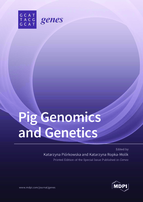Pig Genomics and Genetics
A special issue of Genes (ISSN 2073-4425). This special issue belongs to the section "Animal Genetics and Genomics".
Deadline for manuscript submissions: closed (23 December 2020) | Viewed by 68952
Special Issue Editors
Interests: pig; chicken; horse genomics; transcriptomics and epigenomics
Special Issues, Collections and Topics in MDPI journals
Interests: pig and horse genomics; transcriptomics and epigenomics
Special Issues, Collections and Topics in MDPI journals
Special Issue Information
Dear Colleagues,
The pig (Sus scrofa) is the most common large mammal in the world. The Sus genus includes domestic pig and wild boar. These animals are omnivores and are biologically similar to humans; thus, they are frequently used as animal models for human medical research. In medical research, molecular biology methods are assisted by agricultural progress, for example, in pig production and breeding. Since the draft reference genome sequence of S. scrofa was assembled in 2012, the processes of identification of genes related to important phenotypic traits and of search of genetic markers for pig selection have been significantly refined. In addition, the newest wide-range high-throughput techniques, including microarrays, next-generation sequencing, and the recent PacBio sequencing platform providing ultra-long sequencing reads, allow identifying gene mutations and gene candidates throughout the whole genome, transcriptome, or epigenome and estimating quantitative traits important for breeding as well as the genetic backgrounds of inherited diseases. In this Special Issue, we will present the state of the art in the field of pig genetics and genomics, including the identification of gene candidates linked to important pig traits and to nutritional modifications, with the aim of collecting the most recent advances. Manuscripts focusing on high-throughput methodologies, such as RNA sequencing, ATAC-seq, MACE-seq, chip-seq, and RRBS, and covering other fields of pig genetics will be appreciated.
Dr. Katarzyna Piórkowska
Prof. Katarzyna Ropka-Molik
Guest Editors
Manuscript Submission Information
Manuscripts should be submitted online at www.mdpi.com by registering and logging in to this website. Once you are registered, click here to go to the submission form. Manuscripts can be submitted until the deadline. All submissions that pass pre-check are peer-reviewed. Accepted papers will be published continuously in the journal (as soon as accepted) and will be listed together on the special issue website. Research articles, review articles as well as short communications are invited. For planned papers, a title and short abstract (about 100 words) can be sent to the Editorial Office for announcement on this website.
Submitted manuscripts should not have been published previously, nor be under consideration for publication elsewhere (except conference proceedings papers). All manuscripts are thoroughly refereed through a single-blind peer-review process. A guide for authors and other relevant information for submission of manuscripts is available on the Instructions for Authors page. Genes is an international peer-reviewed open access monthly journal published by MDPI.
Please visit the Instructions for Authors page before submitting a manuscript. The Article Processing Charge (APC) for publication in this open access journal is 2600 CHF (Swiss Francs). Submitted papers should be well formatted and use good English. Authors may use MDPI's English editing service prior to publication or during author revisions.
Keywords
- Porcine genetics
- Breeding
- Genetic markers
- RNA-sequencing
- Animal genomics
- Pig traits







